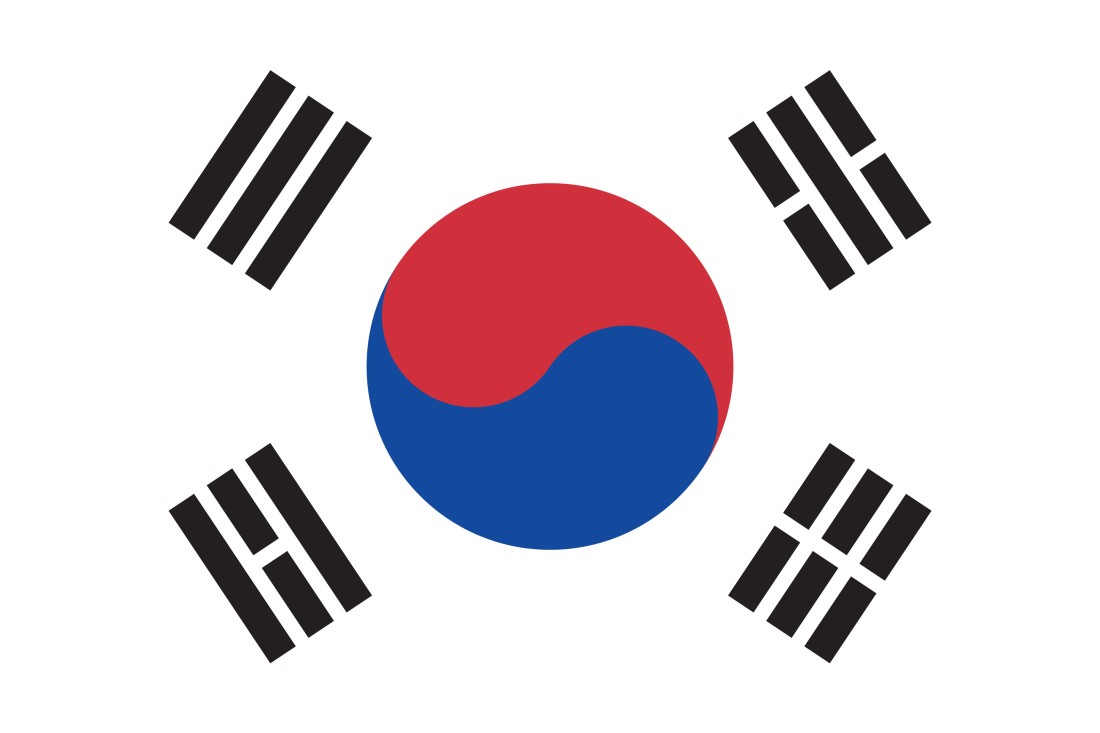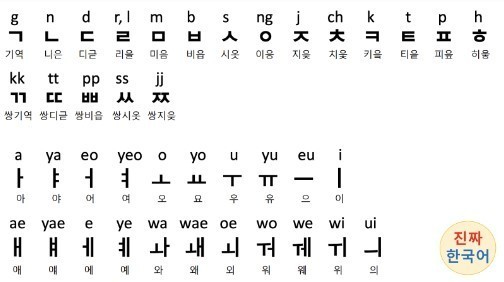Culture
National Flag: Taegeukgi (태극기)
출처: 대한민국 행정안전부 홈페이지
The Taegukgi has three parts:
- A white rectangular background
- A red and blue Taegeuk in the centre
- Four black trigrams (one in each corner)
The white background represents peace and purity. The circle in the flag’s centre symbolizes balance in the world (blue = sky, red = land).
Overall, the trigrams represent harmony and movement as fundamental principles. Each trigram (괘 [gwae]) represents one of the four classical elements:
- Geon: heaven
- Gon: earth
- Gam: moon
- Ri: sun
South Korea adopted the Taeguki as its national flag when the country gained independence from Japan on 15 August 1945.
Korean Alphabet: Hangul (한글)
출처: Real Korean Language, 2019
The Korean Alphabet, known as Hangul is the modern official writing system for the Korean language. The letters for the five basic consonants reflect the shape of the speech organs used to pronounce them, and they are modified systemically to indicate phonetic features. Similarly, the vowel letters are systemically modified for related sounds, making hangul a featural writing system.
In 1443 CE, Hangul was created by King Sejong the Great in an attempt to increase literacy by serving as a complement to the logographic Sino-Korean Hanja, which had been used by Koreans as its primary script to write the Korean language along with the usage of Classical Chinese. Hangul was initially denounced and disparaged by the Korean educated class.
Modern Hangul orthography uses 24 basic letters: 14 consonant letters + 10 vowel letters. Also, there are 27 complex letters that are formed by combining the basic letters: 5 tense consonant letters, 11 complex consonant letters, and 11 complex vowel letters.
Martial Arts: Taekwondo (태권도)
Taekwondo is a Korean form of material art characterized by punching and kicking techniques, with emphasis on spinning jump kicks, head-height kicks, and fast kicking techniques. The physical training undertaken in Taekwondo is purposeful and fosters strength of mind through mental armament.
The oldest governing body for Taekwondo is the Korea Taekwondo Association (KTA), formed in 1959. The main international organizational bodies for Taekwondo today are the International Taekwon-Do Federation (ITF), founded by Choi Hong-hi in 1966.
Gyeorugi, a type of full-contact sparring, has been an Olympic event since 2000. In 2018, the South Korean government designated Taekwondo as Korea’s national material art. The governing body for Taekwondo in the Olympics and Paralympics is World Taekwondo.
Important Dates & Events
Korean New Year: Seollal (설날)
Seollal is a festival and national holiday commemorating the first day of the Korean calendar. During this time, many Koreans visit family, wear the hanbok, eat Korean food, and play folk games. In addition, children often receive money called Sebaetdon (New Year’s money) as a gift from their elders after performing a formal bow.
National Liberation Day of Korea:
Gwangbokjeol (광복절)
Date: August 15th
The National Liberation Day of Korea is a holiday celebrated annually on 15 August (8/15). It commemorates Victory over Japan Day when the United States and the Soviet Union liberated Korea from 35 years of Japanese rule.
The name Gwangbokjeol is composed of the Korean words:
- 광 (Gwang): Light
- 복 (Bok): Restoration
- 절 (Jeol): Holiday
The word ‘restoration’ is used rather than the word for ‘independence’ in order to illustrate how Korea had been a nation for centuries prior to Japanese rule.
The Korean Alphabet Day:
Hangul Day (한글날)
Date: October 9th
The Korean Alphabet Day, known as Hangul Day, is a national Korean commemorative day marking the proclamation and invention of Hangul by the 15th-century Korean King Sejong the Great. Hangul Day has been a national holiday in South Korea since 1970.



